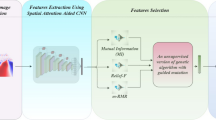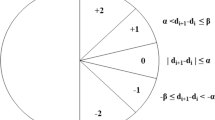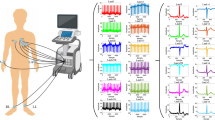Abstract
On the basis of analysing the characteristics of hand movement surface electrocardiogram electromyogram (sEMG) signals, we propose a feature extraction and classification method for hand movement sEMG signals based on a multi-method integration combining the wavelet, fractal and statistics methods. To start, the hand movement sEMG signals are de-noised by using the wavelet transform, the de-noised and reconstructed signals are decomposed, and the average high frequency coefficients in each scale space are calculated to constitute the feature vectors as the first part of the hand movement sEMG signals classification features. Next, according to the characteristics of hand movement sEMG signals and the classification needs, we analyse the multi-fractal spectrum of the de-noised and reconstructed signals at multiple scales and extract the relevant parameters of multi-fractal spectrum as the second part of the hand movement sEMG signals classification features. Then, according to the characteristics of hand movement sEMG signals, we extract the relevant statistical characteristics of sEMG signals as the third part of hand movement sEMG signals classification features. According to the extracted features, we use the Least Square Support Vector Machine and the Backpropagation neural network as classifiers to individually classify and combine the characteristics of hand movement sEMG signals and the experimental results. The final classification features are identified to accomplish the classification of hand movement sEMG signals. Finally, the advantages of the proposed method are illustrated by comparative analysis from multiple perspectives.




Similar content being viewed by others

References
Al-Timemy AH, Bugmann G, Escudero J et al (2013) Classification of finger movements for the dexterous hand prosthesis control with surface electromyography. IEEE J Biomed Health Inform 17(3):608–618
Wang N, Lao K, Zhang X (2017) Design and myoelectric control of an anthropomorphic prosthetic hand. J Bionic Eng 14(1):47–59
Azorin-Lopez J, Saval-Calvo M et al (2016) A novel prediction method for early recognition of global human behavior in image sequence self-organizing maps for the analysis of complex movement patterns. Neural Process Lett 43(2):363–387
Guan L, Yi J, Li J, He R et al (2013) A control system or the myoelectric prosthetic hand with adjustable grip speed. Chin J Biomed Eng 32(4):471–476
Alfaro-Ponce M, Salgado I, Arguelles A et al (2016) Adaptive identifier for uncertain complex-valued discrete-time nonlinear systems based on recurrent neural networks. Neural Process Lett 43(1):133–153
Shi J, Zhou M, Zhu Z et al (2010) Feature extraction of surface electromyogram based on wavelet packet transform. Micro Comput Inf 26(3–1):42–46
Qiu Q (2009) Feature extraction and pattern classification of electromyographic signals. Dissertation, Shanghai Jiao Tong University
Liu Y (2015) The recognition of sEMG hand actions based on SVM. Dissertation, Harbin University of Science and Technology
Guo S, Pei Q (2017) Application of short-time Fourier transform to high-rise frame structural-health monitoring based on change of inherent frequency over time. J Chongqing Univ (Engl Ed) 16(1):1–10
Wang H, Li K, Sun H et al (2011) Feature extraction method based on Pseudo-Wigner-Ville distribution for rotational machinery in variable operating conditions. Chin J Mech Eng 24(4):661–668
Qiu Q, Zhu X (2010) Feature extraction and pattern reorganization of surface electromyography signal based on spectrum analysis. J Clin Rehabil Tissue Eng Res 14(4):645–648
Wang G (2008) The analysis of surface electromyographic signal based on wavelet transform and multifractal analysis. Dissertation, Shanghai Jiao Tong University
Wang H, Chen J, Dong G (2014) Feature extraction of rolling bearing’s early weak fault based on EEMD and tunable Q-factor wavelet transform. Mech Syst Signal Process 48(1–2):103–119
Li T (2015) High-speed train multifractal feature extraction and fault diagnosis. Ind Control Comput 28(7):68–72
Disselhorst-klug C, Schmitz-rode T, Rau G (2008) Surface electromyography and muscle force: limits in sEMG-force relationship and new approaches for applications. Clin Biomech 24(3):225–235
Wang J (2015) Methods of feature extraction and gait recognition for lower extremity based on electromyographic signals. Dissertation, Hangzhou Dianzi University
Sapsanis C, Georgoulas G, Tzes AD (2014) sEMG for basic hand movements DataSet.http://archive.ics.uci.edu/ml/datasets/sEMG+for+Basic+Hand+movements
Gao Y (2014) Study on pattern recognition of hand motion modes based on surface electromyography signal. Dissertation, Shanghai Normal University
Mahdi K, Mehran J (2011) A neuro-fuzzy inference system for sEMG-based identification of hand motion commands. IEEE Trans Ind Electron 58(5):1952–1960
Sun B (2013) Research on the classification of surface EMG based on neural network. Dissertation, Jilin University
Yang S (2015) Research of surface EMG classification of hand movement based on AdaBoost algorithm. Dissertation, Jilin University
Funding
This work was supported by the 2013 Heilongjiang Province Natural Science Foundation (Grant No. F201348); the 2014 Harbin Science and Technology Innovation Talents Project (Grant No. 2014RFXXJ054); and the 2013 Harbin University of Commerce Doctor Scientific Research Project (Grant No. 13DL004).
Author information
Authors and Affiliations
Corresponding author
Ethics declarations
Conflict of interest
The authors declare that they have no conflict of interest.
Rights and permissions
About this article
Cite this article
Ge, L., Ge, LJ. & Hu, J. Feature Extraction and Classification of Hand Movements Surface Electromyogram Signals Based on Multi-method Integration. Neural Process Lett 49, 1179–1188 (2019). https://doi.org/10.1007/s11063-018-9862-0
Published:
Issue Date:
DOI: https://doi.org/10.1007/s11063-018-9862-0



